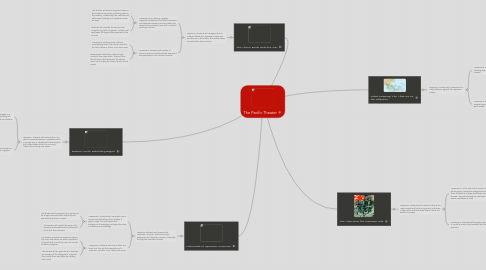
1. Internment of Japanese Americans
1.1. Objective:Students will examine the Japanese American internment camp experience and develop a sense of empathy through the simulation activity
1.1.1. Assessment:: Students will complete a Four Square activity that has them analyze a given image. This will assess their background knowledge and helps them tap into their prior knowledge.
1.1.1.1. The student will be exposed to a portion of an image and write down what they see and what they think it means.
1.1.1.2. The teacher will control the pace of the activity and provide time for students to share with their partners.
1.1.2. Assessment: Students will write a letter to a loved one through the perspective of a Japanese American in an internment camp.
1.1.2.1. The teacher provides examples and gives out clear instructions on what is expected. They will walk around the room to monitor students' progress.
1.1.2.2. The student will be given time to evaluate an example of the assignment. They will then create their own letter by utilizing their notes.
2. The Atomic Bomb Ends the War
2.1. Objective: Students will recognize that in order to defeat the Japanese military and end the war in the Pacific, the United States unleashed the atomic bomb.
2.1.1. Assessment: By utilizing a graphic organizer, students will be able to compare and contrast President Truman’s letter and excerpts from Barefoot Gen with 4-5 bullet points per section.
2.1.1.1. The teacher will hand out guided notes so that students can focus on the big ideas in the reading. Additionally, the instructor will walk around making sure students remain on tasks.
2.1.1.2. Students will evaluate the sources and complete a graphic organizer. Students will synthesize the arguments presented in the sources.
2.1.2. Assessment: Students will be able to choose a side and construct their argument and participate in the Socratic Seminar.
2.1.2.1. The teacher will keep track of those participating within the Socratic Seminar and will intervene if their is no discu.ssion
2.1.2.2. Students will utilize their notes to help construct their arguments. They will lead the discussion that examines the ethical issues surrounding the atomic bomb and its impact.
3. Postwar World: Rebuilding Begins
3.1. Objective: Students will evaluate the US's plans for peacekeeping in a postwar world. In groups of 3-4, students will discuss what the United States did to the surviving leaders of Germany and Japan.
3.1.1. Assessment: Students will engage in a think-pair-share activity where they will discuss the meaning of political cartoons.
3.1.1.1. The teacher will pace the slide show that shows the political cartoon. The teacher will allow students enough time to share with their partner and walk around the room and listen to the dialogue.
3.1.2. Assessment: Students will participate in a Jigsaw activity and complete a graphic organizer.
3.1.2.1. Students will first write down what they see, what they think it means, and what the purpose of the political cartoon is. Then they will share with their partner.
3.1.2.2. The teacher will place students in groups of 3-4 and assign each group a source. They will continue to walk around the room and take time to visit each group to help facilitate learning and make sure they remain on task.
3.1.2.3. Students will become experts on a given source and exchange information with other group members. They will complete their graphic organizer by collaborating with each other.
4. The Allies Stem the Japanese Tide
4.1. Objective: Students will be able to identify the major events and key turning points in the war in the Pacific and how these events led to the Battle of Midway.
4.1.1. Assessment: At the end of the lecture, students will be given a quickwrite assignment that asks them to sketch and draw what they have learned. They will identify key concepts and events mentioned in class.
4.1.1.1. Teacher gives a digital lecture through prezi on the events leading to the Battle of Midway. During the moments of discussion, the instructor walks around to make sure everyone is on task and stepping in when needed.
4.1.1.2. Students follow along with the provided guided notes and do mini-activities as requested. They finish off with a quickwrite reflecting on what they have learned.
4.1.2. Assessment: Students will be given instruction to create a timeline that answers the historical question.
4.1.2.1. Teacher provides feedback on their quickwrite and instructs students about the timeline project. They offer examples on what is expected but making sure to clarify any questions.
4.1.2.2. Student will have the option to create the timeline on paper or online. They will sequence the events in chronological order providing images and data to accommodate each event.
5. Island Hopping/ The Allies Go on the Offensive
5.1. Objective: Students will understand the Allied offensive against the Japanese military.
5.1.1. Assessment: Students will take a Map Labeling Exam on the events in the Pacific Theater.
5.1.1.1. Teacher instructor will ensure all students have the opportunity to take the test. The instructor will make sure the students' needs are met by providing accommodations to those who need it.
5.1.1.2. Student will demonstrate their content knowledge and comprehension by taking the exam.
5.1.2. Assessment: Students will work in their assigned groups to create exhibit with their given events.
5.1.2.1. Teacher gives the students the necessary materials and information for students to work on their exhibit. The teacher will walk around to make sure students remain on task.
5.1.2.2. Students have time in class to focus on their event and create an exhibit. Each group member will verbally talk about portions of their exhibit throughout the gallery-walk. Students will use their pre-reading questions to examine exhibits.

